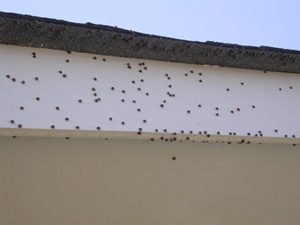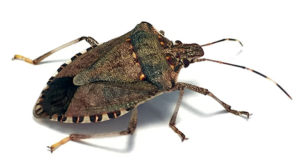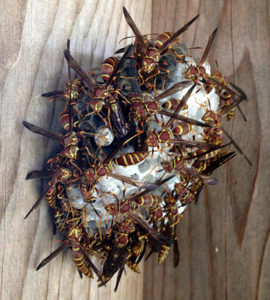The following was cross-posted from the Extension Entomology website.
In spite of our continued warm weather, several of our typical cool-weather pests have begun their fall invasion of homes and commercial buildings. This is actually not surprising since this move to seek overwintering sites is due not just to temperature but also the shortening day-length and decline in suitable food plants.
Kudzu bugs are moving out of kudzu and soybean fields and flying to nearby structures, particularly those with light-colored siding (as seen in the figure to the right). As many people discover, spraying siding, window trim, etc. is likely to produce mediocre results even if repeated sprays are applied. Many of the labels for the pyrethoid pesticides (those containing chemicals such as lamda-cyhalothin, cyfluthrin, bifenthrin, etc.) also limit their application to vertical areas above impervious surfaces (such as driveways, sidewalks, patios) where rain could wash the chemical off the treated surfaces and allow them to run off into storm drains. We have additional information at:
Brown Marmorated Stink Bugs (BSMB) are also making their presence known across the state, particularly in the Piedmont, Foothills, and western NC. This pest causes significant damage to a wide variety of fruit, vegetable and row crops as well as ornamentals. Although control is possible for these crops, preventing the stink bug’s invasion of homes is difficult. As with kudzu bugs, surface sprays to building exteriors or around windows and doors is rarely effective.
For more information about BMSB, visit:
- Brown Marmorated Stink Bug in the Landscape and in the Home
- Brown Marmorated Stink Bug (North Carolina)
Paper Wasps (Polistes sp.) colonies reached their peak size a few weeks ago with the production of next year’s queens and are now starting to disperse. Although the workers and this year’s queen will die over the next few weeks, some workers along with next year’s queens will abandon their nests and look for overwintering sites. This activity often results in wasps finding gaps near chimneys or roof ridge vents or windows and doors and then showing up indoors. Many people assume that there is an active nest inside a wall or some other hidden area (e.g., attached to the underside of a deck).
However, the wasps could also be coming from nests out in storage buildings, tree holes, firewood piles, old unused cars, or other items that have been undisturbed for much of the summer. Spraying the exterior of the building (not spraying a specific nest) is not going to keep this activity which will continue until we see cold (frost). Even then, warm winter days may cause the wasps to become active. Bear in mind that there is not a functioning nest and so the wasps are not aggressively defending a nest. However, if you step on one or swat at one, it may sting in defense..
We have more information at: Controlling Paper Wasps in and Around Structures
Mike Waldvogel and Patty Alder, NC State University Extension





 The problems that follow disasters such as Hurricane Matthew with loss of electricity and water, as well as damage to our homes, schools and workplace, bring a variety of unwanted pest problems as well. The extent of these problems depends in part the seasonal cycle of pest activity. Visit our
The problems that follow disasters such as Hurricane Matthew with loss of electricity and water, as well as damage to our homes, schools and workplace, bring a variety of unwanted pest problems as well. The extent of these problems depends in part the seasonal cycle of pest activity. Visit our